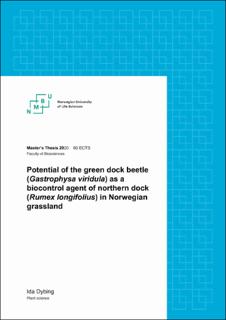| dc.description.abstract | Docks (Rumex spp.) act as weeds in many parts of the world, and in Norwegian grasslands, the northern dock (Rumex longifolius) is the most widespread dock species. The ability of farmers to control docks without the use of chemical herbicides is thought to be a limiting factor in the conversion to organic farming. The purpose of this study, including three experiments, was to investigate the potential of the indigenous green dock beetle (Gastrophysa viridula) for biological control of R. longifolius via the inundative method in Norwegian grasslands. Firstly, the effect of different applied developmental stages and densities of G. viridula on R. longifolius seedling growth and survival, when grown under competition from perennial ryegrass (Lolium perenne), was examined in a field experiment in summer 2009 to summer 2010. Secondly, the effect of grazing by G. viridula on dock growth when R. longifolius seedlings were grown alone, under competition from Italian ryegrass (Lolium multiflorum), or a “ley mixture” containing forage species commonly used in Norwegian leys, was examined in a glasshouse experiment in autumn 2019. Thirdly, the dispersal of G. viridula in a perennial ley was examined in a field experiment in summer 2019. In the grazing field experiment, G. viridula, when applied as third instar larvae, significantly reduced the percentage leaf area remaining of the four oldest dock leaves, the survival of docks to the following year, and shoot weight the following year when compared to the control. While when applied as gravid females, G. viridula was not able to reduce dock growth or survival compared to the control. The most effective densities of third instar larvae in reducing dock growth and survival were 250 and 500 larvae per 16 dock plants. In the glasshouse experiment, G. viridula applied as gravid females and apparent males were able to significantly reduce the shoot and root growth of R. longifolius regardless of competition level. The most significant effect on root dry weight, when compared to an ungrazed, non-competing control, was found when dock plants were exposed to both grazing and competition, irrespective of with which species the docks were competing. The final root dry weight of grazed, competing docks were 71.9 – 72.9 % less than that of ungrazed, competing docks. The expected dispersal of G. viridula in a perennial ley within the completion of one generation was found to be between 5 and 15 meters. The potential of G. viridula as a biocontrol agent of R. longifolius in Norwegian grasslands was found to be high, with the highest efficacy when applying third instar larvae at a density of 250 larvae per 16 dock plants, but also a good effect of applying gravid females in one of the two experiments. The ultimate effect on dock root dry weight, when grazed by G. viridula, appears to be independent of whether it is grown in competition with Italian ryegrass or a ley mixture, indicating that G. viridula may be able to compensate to some extent for differences in competitive ability between grasses/ley mixtures. Short dispersal in the field indicates that releases of G. viridula in the field would have to be at close intervals (m) or within dock patches. | en_US |
| dc.description.abstract | Høymole (Rumex spp.) opptrer som ugras i mange deler av verda, og i norsk grasmark er vanleg høymole (R. longifolius) den mest utbreidde arten. Bondens evne til å kontrollere høymole utan bruk av kjemiske herbicid er trudd å vere ein hemjande faktor i overgangen til økologisk landbruk. Føremålet med denne studien, som inkluderte tre forsøk, var å undersøkje den innfødde syrebladbillas (Gastrophysa viridula) potensial til biologisk kontroll av vanleg høymole ved overfløymingsmetoden i norsk grasmark. (1) I eit feltforsøk frå sommaren 2009 til sommaren 2010 vart effekten av syrebladbiller tilført ved ulike utviklingsstadium og tettleikar på frøplanter av vanleg høymole som vaks under konkurranse frå fleirårig raigras (Lolium perenne), undersøkt. (2) I eit veksthusforsøk hausten 2019 vart effekten av herbivori frå syrebladbiller på vekst av frøplanter av vanleg høymole, når plantene vaks aleine, med konkurranse frå Italiensk raigras (Lolium multiflorum) eller frå ei vanleg engfrøblanding, undersøkt. (3) I eit feltforsøk sommaren 2019 vart spreiinga av syrebladbiller i ei fleirårig eng undersøkt. | en_US |

